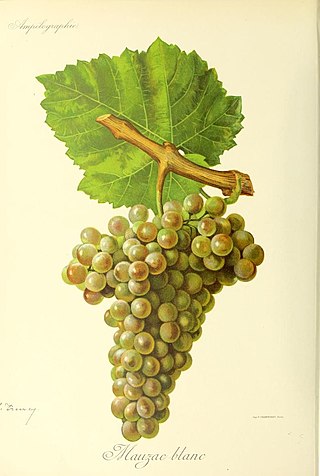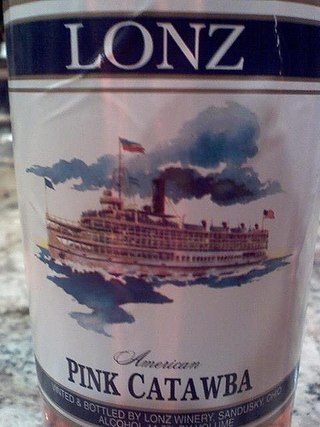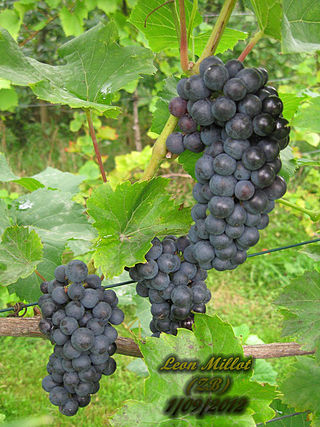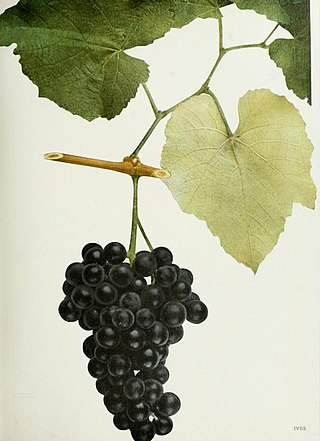The topic of this article may not meet Wikipedia's general notability guideline .(October 2023) |
Flora is the name of two unrelated varieties of grape, one white and one red, both of United States origin.
The topic of this article may not meet Wikipedia's general notability guideline .(October 2023) |
Flora is the name of two unrelated varieties of grape, one white and one red, both of United States origin.
The white Flora is a California wine grape. It is a crossing of Semillon and Gewürztraminer, both Vitis vinifera varieties, and it was created in 1938 by Harold P. Olmo at the California Agricultural Experiment Station. [1] [2]
The red Flora is an interspecific hybrid between V. vinifera and Vitis labrusca , and it was created in 1850 by A. M. Spangler. [3]

Aurore is a white complex hybrid grape variety produced by French viticulturist Albert Seibel and used for wine production mostly in the United States and Canada. Over a long lifetime, Seibel produced many complex hybrid crosses of Vitis vinifera to American grapes. The Aurore grape is a cross of Seibel 788 and Seibel 29.

Mauzac or Mauzac blanc is a white variety of grape used for wine, of the species Vitis vinifera. It is mainly grown in the Gaillac and Limoux regions in southwest France. Total French plantations of Mauzac stood at 3,200 hectares in the year 2000.

Catawba is a red American grape variety used for wine as well as juice, jams and jellies. Grown predominantly on the East Coast of the United States, this purplish-red grape is a likely a hybrid of the native American Vitis labrusca and the Vitis vinifera cultivar Semillon. Its exact origins are unclear but it seems to have originated somewhere on the East coast from the Carolinas to Maryland.

Regent is a dark-skinned inter-specific hybrid grape variety, used for making wine. It has both European and American vine species in its pedigree and a broad resistance against the most significant fungal diseases which affect grapes, such as downy mildew.

Harold Olmo was an American viticulturist and professor at the University of California, Davis where he created many new grape varieties known today as Olmo grapes. In the 1950s, he helped to establish California's first quarantine facility on the UC Davis campus to permit California growers to import foreign vines. This led to an expansion of California's wine industry as more Vitis vinifera was introduced to the area.

Torrontés is a white grape variety, mostly produced and known in Argentina, producing fresh, aromatic wines with moderate acidity, smooth texture and mouthfeel as well as distinctive peach and apricot aromas on the nose. Three Torrontés varieties exist in Argentina: Torrontés Riojano, the most common, Torrontés Sanjuanino, and Torrontés Mendocino. It is primarily Torrontés Riojano that has received attention for the quality of its wines, and is the variety used for most Argentine wines simply labeled Torrontés.

Solaris is a variety of grape used for white wine. It was created in 1975 at the grape breeding institute in Freiburg, Germany by agricultural scientist Norbert Becker.
Courbu is the name of three different, but related varieties of wine grapes primarily found in South West France. All are Vitis vinifera grapes. The name Courbu, without suffix, can refer to both Petit Courbu and Courbu blanc, and not all sources differ between the two.

Helfensteiner is a dark-skinned German wine grape crossing of the species Vitis vinifera, that was created in 1931 with the crossing of Frühburgunder and Trollinger. It was created by August Herold at the grape breeding institute in Weinsberg in the Württemberg region.

Léon Millot is a red variety of hybrid grape used for wine. It was created in 1911 in the Oberlin Institute in Colmar, Alsace, by the French viticulturist Eugène Kuhlmann (1858–1932) by crossing the hybrid grape Millardet et de Grasset 101-14 O.P. with Goldriesling, which is Vitis vinifera. The variety was named after the winemaker and tree nursery owner Léon Millot.
Alicante Ganzin is a red French wine grape variety. Unlike most Vitis vinifera wine grapes, Alicante Ganzin is a teinturier with dark flesh that produces red juice. Most varieties used to produce red wine, such as Cabernet Sauvignon, Syrah, etc., have clear color flesh and juice with the wine receiving its color through a maceration process where the color seeps out of the grape skins for as long as they are in contact with the juice. Alicante Ganzin can thus produce light red and rose colored wine without maceration. It is believed that Alicante Ganzin is often described as the progenitor of all French teinturier grapes.

Olmo grapes are wine and table grape varieties produced by University of California, Davis viticulturist Dr. Harold Olmo. Over the course of his nearly 50-year career, Dr. Olmo bred a wide variety of both grapes by means of both crossing varieties from the same species or creating hybrid grapes from cultivars of different Vitis species.
Taminga is white Australian wine grape variety that was developed in the late 20th century by viticulturalist and grape breeder Alan J. Antcliff at CSIRO. It is a cross of a previously created crossing Merbein 29-56 and the Vitis vinifera variety Traminer Rot (Gewürztraminer) Like Tarrango, a 1960s crossing between Touriga Nacional and Sultana, Taminga was bred to maintain high acidity levels while growing in hot Australian vineyards. Early results from Taminga show that it can ripen consistently in different vineyard location and produce wines that wine expert Jancis Robinson describes as "commercially acceptable.
Royalty is a rouge Californian wine grape variety that was developed in 1938 by Dr. Harold P. Olmo of the University of California, Davis. The grape is a red fleshed teinturier which, unlike most red wine grapes, will produce red-tinged colored wine even without maceration time on the skins. The grape is a hybrid produced from the Vitis vinifera Trousseau gris variety from the Jura wine region of France and the teinturier grape Alicante Ganzin that is itself a hybrid of a Vitis rupestris variety and the Vitis vinifera grape Aramon.
Cascade is a red complex hybrid grape variety that was created by French viticulturist Albert Seibel in the early 20th century in Aubenas, Ardèche, in the Rhône Valley. It has been commercially available in North America since 1938 and has since been planted in Canada and the United States. However, in warmer climates, the grape is highly susceptible to a number of grapevine viruses, which has discouraged plantings of the variety.

Ives noir is a red hybrid grape variety that is grown throughout the United States. Named after its propagator, Connecticut wine grower Henry Ives, the grape's pedigree and exact origin are unclear. After Prohibition in the United States, Ives was a popular grape used in the production of sweet, port-style wines but saw its plantings steadily decrease throughout the 20th century as the vine's susceptibility to air pollution took its toll.
Landot noir is a red hybrid grape variety that is a crossing of Landal and Villard blanc. Created after a series of trials between 1929-1949, the grape was introduced to Canada and the United States in the 1950s and today can be found in Quebec as well as New Hampshire where a varietal is produced by Jewell Towne Vineyards.

Muscat bleu is a red Swiss wine and table grape variety that is a hybrid of Garnier 15-6 and Perle noire. The grape was developed in Peissy in the Canton of Geneva by Swiss grape breeder Charles Garnier in the 1930s. Today the grape is used as both a table grape and for winemaking, producing wines that Master of Wine Jancis Robinson describe as "soft and grapey". Outside Switzerland, some plantings of Muscat bleu can also be found in Belgium.
Landal noir is a red hybrid grape variety that was created during a series of trials between 1929 and 1942 by French grape breeder Pierre Landot at his Conzieu nursery in the Ain department of eastern France. The grape is a crossing of two Seibel grapes, Plantet and Seibel 8216. While authorized for use in several French wine growing region, the grape is officially not recommended for use in any quality wine production in France with only 49 hectares of the variety reported in 2008. Outside France, some plantings of Landal noir can be found in Switzerland, Canada and the United States.